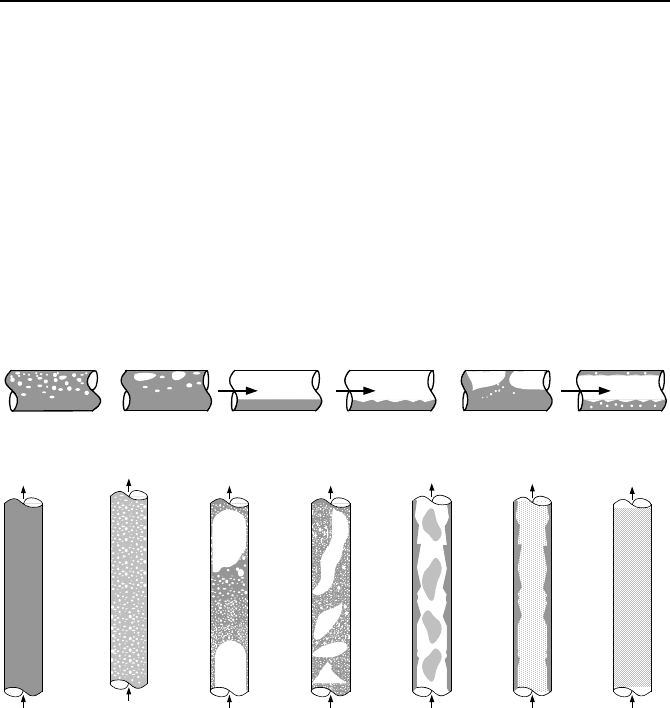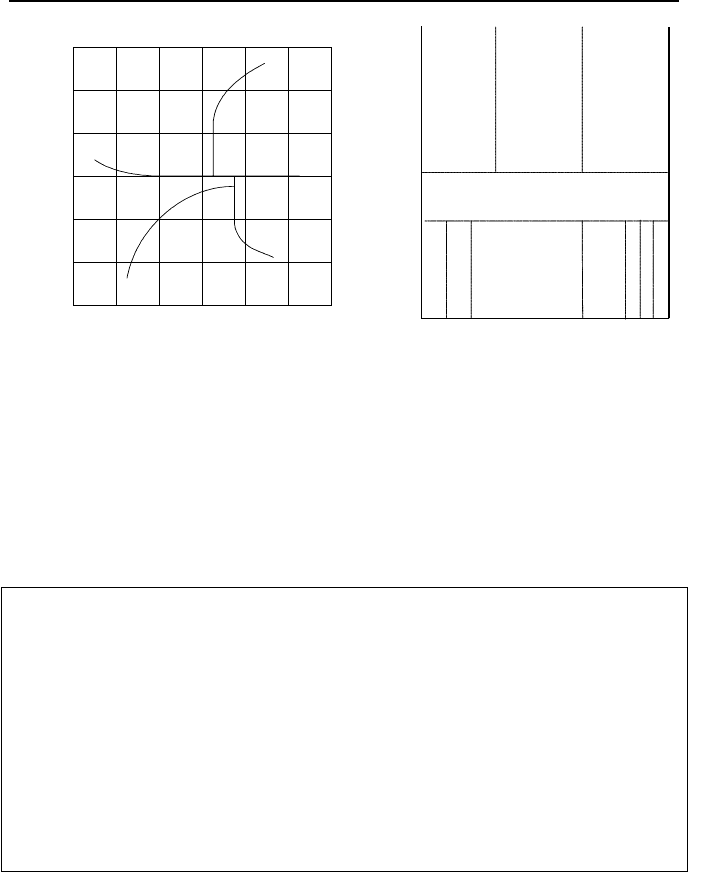Massoud M. Engineering Thermofluids: Thermodynamics, Fluid Mechanics, and Heat Transfer
Подождите немного. Документ загружается.


602 Va. Two-Phase Flow and Heat Transfer: Two-Phase Flow Fundamentals
Multicomponent flow refers to the flow of several phases having different
chemical composition such as the flow of water, steam and air.
Thermodynamic equilibrium exists between phases when the liquid (l) and
vapor (v) phases are at equal temperature, T
l
= T
v
.
Homogeneous is applied to two phases that flow at the same speed in the same
direction.
Homogenous Equilibrium Model (HEM) is a means of mathematically de-
scribing two-phase flow, where
l
V
K
=
v
V
K
(same flow direction at the same veloc-
ity) and also T
l
= T
v
(thermodynamic equilibrium). If phase velocities are not
equal (
vl
VV
KK
≠ ) but temperature of the phases are, then the mathematical model
for analysis of the two-phase flow is referred to as the Separated Homogeneous
Model or SEM.
Quality is defined in various ways depending on the type of application. For
example, considering steam and water, in Chapter II, we defined quality as x =
m
g
/m, referred to as the static quality, and may also be written as x
s
. The thermo-
dynamic quality is defined as x = (h – h
f
)/h
fg
, also written as x
e
for equilibrium
quality. The flow quality for a mixture of water and steam is defined as the ratio
of mass flow rate of steam to mass flow rate of the mixture:
X =
m
m
g
The flow quality, X, and thermodynamic quality, x, become equal only when
thermal equilibrium conditions exist. Thus, X = x only if T
f
= T
g
.
Void fraction in a control volume made up of liquid and gas mixture is the vol-
ume fraction of the gas phase. Hence, void fraction (
α
g
or simply
α
) is given by
α
= V
g
/V. Similarly, 1 –
α
= V
f
/V. Note that void fraction is a space and time aver-
aged quantity. The static quality, as defined above, can be expressed in terms of
void fraction by noting that x = m
g
/(m
f
+ m
g
) =
ρ
g
V
g
/(
ρ
f
V
f
+
ρ
g
Vg) =
ρ
g
α
V/[
ρ
f
(1 –
α
) +
ρ
g
α
]V. Hence,
()
αραρ
αρ
gf
g
x
+−
=
1
Mixture density is given by
ρ
= (m
f
+ m
g
)/V. Substituting for m
f
=
ρ
f
V
f
and m
g
=
ρ
g
V
g
, we find
ρ
=
ρ
f
V
f
/V +
ρ
g
V
g
/V. Since V
f
/V = 1 –
α
and V
g
/V =
α
, the mix-
ture density in terms of void fraction becomes:
ρ
= (1 –
α
)
ρ
f
+
αρ
g
Phasic mass flux, is the mass flow of a given phase per mixture area. Thus, for
a mixture of water and steam for example, G
g
=
g
m
/A. Using the definition of

1. Definition of Two-Phase Flow Terms 603
flow quality, G
g
= X m
/A = XG. Similarly, for water we have G
f
=
f
m
/A.
Substituting, G
f
= (1 – X) m
/A = (1 – X)G where G is the mixture mass flux.
Mixing cup density is similar to the mixture density but is averaged with re-
spect to the phasic mass flux; v’ =
222
/])1([/1 GVV
ggff
αραρρ
+−=
′
. Simi-
lar to the mixing cup density, a mixing cup enthalpy is defined as;
GhVhVh
gggfff
/])1(['
αραρ
+−=
Phasic volumetric flow rate is defined similar to the single-phase flow hence,
for the gas component of a mixture,
ggg
m
ρ
/V
=
= XGA/
ρ
g
and for the liquid
component
fff
m
ρ
/V
=
= (1 – X)GA/
ρ
f
.
Superficial velocity is the velocity a phase would have if it were flowing alone
in a channel. As such, the superficial velocity is obtained by dividing the related
volumetric flow rate by the mixture area. For example, for the flow of water and
steam in a channel, while water velocity is given by V
f
=
f
V
/A
f
, where A
f
is the
water flow area, the superficial velocity for water is defined as J
f
=
f
V
/A where A
is total flow area of the channel. Similarly, the superficial velocity of steam is
found as
gg
J V
= /A. To relate the superficial velocities to flow quality, we
write:
J
g
=
g
V
/A = )/( Am
gg
ρ
= G
g
/
ρ
g
= XG/
ρ
g
Similarly, for J
f
we find
J
f
= (1 – X)G/
ρ
f
We now define J = J
f
+ J
g
. Substituting for J
f
and J
g
, we find J to be given by J =
[(1 – X)/
ρ
f
+ X/
ρ
g
]G. We also note that J
g
=
g
V
/A = V
g
A
g
/A = aV
g
. Similarly, for
the liquid phase we have J
f
= (1– a)V
f
.
Slip ratio is defined as the ratio of the gas velocity to liquid velocity, S = V
g
/V
f
.
Substituting, we find;
S =
f
g
V
V
=
()
α
α
−1/
/
f
g
J
J
=
¸
¸
¹
·
¨
¨
©
§
¸
¹
·
¨
©
§
−
¸
¹
·
¨
©
§
−
=
−
−
g
f
f
g
X
X
GX
XG
ρ
ρ
α
α
ρ
ρ
α
α
1
1
/)1(
/
1
Va.1.1
Thus, the slip ratio relates X and
α
. If for simplicity, we represent the quality and
the density ratios with y:

604 Va. Two-Phase Flow and Heat Transfer: Two-Phase Flow Fundamentals
f
g
X
X
y
ρ
ρ
−
=
1
Equation Va.1.1 simplifies to:
α
α
y
S
)1( −
=
Va.1.2
from which we can find void fraction as:
()
1
1
−
+= yS
α
Va.1.3
Volumetric flow ratio as defined for the gas phase is given as
β
=
g
V
/ V
=
J
g
/J, which may be written as:
J
J
J
JJ
J
J
ffg
−=
−
== 1
β
Substituting for the superficial velocities in terms of flow quality X and mass flux
G, we find:
()
1
1
−
+= y
β
Va.1.4
Alternatively, by substituting for y from its definition above, we find:
fgf
g
X
X
vv
v
+
=
β
Va.1.5
Wallis number is the ratio of inertial force to hydrostatic force on a bubble or
drop of diameter D. Hence, the Wallis number (Wa) can be defined for both gas
and liquid. For example,
Wa
g
= [
ρ
g
/gD(
ρ
f
–
ρ
g
)]
0.5
J
g
.
Kutateladze number is defined similarly to the Wa number except for the
length scale D, which is replaced by the Laplace constant [
σ
/g(
ρ
f
–
ρ
g
)]
0.5
. Hence
for a gas the Ku number becomes;
Ku
g
=
()
[]
ggfg
Jg
5.0
)(/
ρρσρ
−
Flooding refers to the condition in which the upward flow of a gas stalls the
downward flow of a liquid. This is accomplished through the momentum transfer
at the liquid-gas interface. According to Wallis for flooding in vertical tubes,

1. Definition of Two-Phase Flow Terms 605
CJJ
fg
=+
5.05.0
where for round tubes C = 0.9 and for sharp-edged tubes
C = 0.75.
Flow reversal refers to condition in which the upward flow of two phases is in-
terrupted by a reduction in gas velocity. The lack of sufficient momentum transfer
at the interface results in the gravity and frictional forces eventually stopping and
finally reversing the flow of liquid. For flow reversal, Ku
g
= 3.2.
Flow patterns of gas-liquid flow in an unheated pipe depend on such factors as
pipe orientation, diameter, mass flux, flow quality, and phasic densities. Patterns
of gas-liquid flow in a horizontal unheated tube and in upflow of a vertical un-
heated tube are shown in Figure Va.1.1.
bubble flow plug flow stratified flow wavy flow slug flow annular flow
liquid flow bubbly flow slug flow churn flow wispy-annular annular flow gas flow
Figure Va.1.1. Flow patterns in horizontal and vertical tubes
Flow pattern map reduces various flow regimes to identifiable patterns. Such
maps associate the key flow parameters to a specific pattern. For a given set of
such parameters, the flow pattern map determines the corresponding flow regime.
Conversely, by knowing the flow regime, we can find a specific range for the key
parameters. An example of such maps is shown in Figure Va.1.2. Hewitt has sug-
gested the left side map for upflow and the right side map is used in the RELAP-5
thermalhydraulic computer code.

606 Va. Two-Phase Flow and Heat Transfer: Two-Phase Flow Fundamentals
Annular
Wispy-annular
Bubbly
Churn
Slugs
Bubbles
slugs
1E0
1E1 1E2 1E3 1E4
1E5
1E6
1E-1
1E1
1E2
1E3
1E4
1E5
1E0
Ψ
x
Ψ
y
Annular
Mist
Bubbly
Mist
Slug
Bubbly
0.0 0.2 0.4 0.6 0.8
1.0
0
2E2
3E2
Transition
Transition
Transition
Transition
Transition
α
G (kg/s m
2
)
Figure Va.1.2. Flow pattern maps for vertical flow (low pressure air-water and high pres-
sure steam-water)
The coordinates of the Hewitt map (left figure) are
2
ffx
JȌ
ρ
= (kg/s
2
·m) and
2
ggy
JȌ
ρ
= (kg/s
2
·m).
Example Va.1.1. Water and steam flow at 1000 psia (~7 MPa) and 2 lbm/s
(~1 kg/s) in a 1 in (2.54 cm) diameter tube. Find the flow regime at a location
where X = 0.2.
Solution: At 1000 psia,
ρ
f
= 46.32 lbm/ft
3
and
ρ
g
= 2.24 lbm/ft
3
. Since A = 3.14 ×
(1/12)
2
/4 = 5.45E-3 ft
2
, then G = 2/5.45E-3 = 366.7 lbm/ft
2
s (1790 kg/s m
2
). Us-
ing Hewitt’s map, we find:
fff
XGJ
ρρ
/)1(
222
−= = 366.7
2
(1 – 0.2)
2
/46.32 = 1858 lbm/s
2
ft
(2765 kg/s
2
·m)
ggg
XGJ
ρρ
/
222
= = 366.7
2
(0.2)
2
/2.24 = 2400 lbm/s
2
ft (3589 kg/s
2
m)
Thus, the flow regime is Wispy – annular.
2. Two-Phase Flow Relation
For two-phase flow in a conduit, there are two methods for solving for such state
parameters as pressure, temperature, and velocity. In the first method, we assign a
control volume to each phase. We then write the three conservation equations of
mass, momentum, and energy for each control volume and solve them simultane-
ously. These control volumes exchange mass, momentum, and energy with each

2. Two-Phase Flow Relation 607
other and exchange momentum and energy with the surface of the conduit. This is
called the two-fluid model. In the second method, being basically a pseudo sin-
gle-phase flow model, we use such parameters as void fraction, slip ratio, and two-
phase friction multiplier to solve for only the three conservation equations written
for the mixture. In this section, we discuss the two-phase flow parameters used in
the pseudo single-phase analysis such as void fraction, flow quality, and slip ratio
as well as pressure differential terms for two-phase flow.
2.1. One Dimensional Relation for Void Fraction
Determination of void fraction is essential in several aspects of two-phase flow
analysis such as calculation of pressure difference terms. Equation Va.1.3 shows
that void fraction varies inversely with the slip ratio. Hence, for given P and X, as
S increases, the void fraction decreases. For example, for the flow of water and
steam at P = 1000 psia and X = 12%,
α
drops from 75% to 40% when S increases
from 1 to 4.
Example Va.2.1. Express the slip ratio only in terms of
α
and
β
.
Solution: We use the definition of
β
given by
β
= {1 + [(1 – X)/X] (
ρ
g
/
ρ
f
)}
–1
to
find 1 –
β
. We then divide these to get (1 –
β
)/
β
= [(1 – X)/X] (
ρ
f
/
ρ
g
). Substituting
in Equation Va.1.1, we obtain:
β
β
α
α
−
−
=
1
1
S
The slip ratio in general is a function of pressure (P), quality (X), and mass
flux (G).
Example Va.2.2. Compare X for the flow of water and steam at 1000 psia for α =
50% and S = 1, 2, and 3.
Solution: We solve Equation Va.1.1 for X to get:
()
S
S
X
gf
g
αρρα
αρ
+−
=
1
At 1000 psia,
ρ
f
= 46.32 lbm/ft
3
and
ρ
g
= 2.24 lbm/ft
3
. Substituting values, we
find:
X = 4.6%, 9%, 12.5% for S = 1, 2, and 3, respectively.

608 Va. Two-Phase Flow and Heat Transfer: Two-Phase Flow Fundamentals
Example Va.2.3. For the flow of steam - water, find
α
,
β
,
ρ
, and x. Use T
sat
=
270 C, X = 0.15, and S = 3.
Solution: At 270 C,
ρ
f
= 767.9 kg/m
3
and
ρ
g
= 28.06 kg/m
3
. Substitute values in
y:
f
g
X
X
y
ρ
ρ
−
=
1
=
9.767
06.28
15.0
15.01 −
= 0.207
Next, we find
α
,
β
, the mixture density, and quality:
α
= 1/(1 + yS) = 1/(1 + 0.207 × 3) = 0.62
β
= 1/(1 + y) = 0.83
ρ
= (1 –
α
)
ρ
f
+
αρ
g
= (1 – 0.62) × 767.9 + 0.62 × 28.06 = 309.2 kg/m
3
x =
ρ
g
α
/[
ρ
f
(1 –
α
) +
ρ
g
α
] = 28.06 × 0.62/[767.9(1 – 0.62) + 0.62 × 28.06] = 0.056.
As specified in Example Va.2.1, slip ratio itself is a function of pressure, mass
flux, density, and void fraction distribution at a given cross section. There are
several correlations for the calculation of slip ratio. An analytical method is of-
fered by Zivi. In this method, the flow kinetic energy is set to a minimum (i.e.,
K.E. =
()
¦
iii
V V
2
ρ
= 0 where subscript i refers to liquid and vapor). If we sub-
stitute for
f
V
and
g
V
from the definition of the phasic volumetric flow rate, we
find:
2
)1(
)1(
..
3
22
3
22
3
AGXX
EK
fg
»
»
¼
º
«
«
¬
ª
−
−
+=
ραρα
Taking the derivative with respect to
α
and setting it equal to zero, we obtain
α
/(1 –
α
) = [X/(1 – X)](
ρ
f
/
ρ
g
)
2/3
. By comparing this result with Equation Va.1.1,
we find that S = (
ρ
f
/
ρ
g
)
1/3
. Since Zivi’s method expresses the slip ratio only in
terms of densities, Zivi’s model does not compare well with experimental data. In
Example Va.2.2, according to Zivi’s method, S is always S = (46.32/2.24)
1/3
=
2.75 for any mass flux. By definition, the homogenous model gives S = 1. Thom,
recognizing the dependency of S on X, developed a relation for S based on best fit
to data for various system pressures. Winterton collected these data in a single
equation in terms of the saturated specific volumes:
S = 0.93(v
g
/v
f
)
0.11
+ 0.07(v
g
/v
f
)
0.561
Va.2.1
This correlation fits Thom’s data well within 1% and can be used for pressures
ranging from atmospheric up to the critical point. To estimate S from Equa-
tion Va.2.1, a thermal equilibrium condition must exist.

2. Two-Phase Flow Relation 609
Example Va.2.4. Water enters a heated channel at rate of 20 kg/s with a degree
of subcooling of 15 C. Use Equation Va.2.1 and a reference pressure of 7 MPa to
find the rate of heat transfer to this channel to ensure the exit void fraction equals
75%.
Solution: To ensure the void fraction at the exit of the heated channel remains at
the specified limit, we need to fix the value of the exit quality from Equation
Va.1.1, with S given by Equation Va.2.1.
Next, having quality at the exit of the channel, we can find the flow enthalpy at the
exit. The rate of heat transfer is subsequently found from a steady-state energy
balance.
At 7 MPa, v
f
= 0.001351 m
3
/kg, v
g
= 0.02737 m
3
/kg, and v
g
/v
f
= 20.26
Substituting in Equation Va.2.1:
S = 0.93(20.26)
0.11
+ 0.07(20.26)
0.561
= 1.67
Having S and
α
e
, we find y § 0.2 from Equation Va.1.2.
Having y,
ρ
f
, and
ρ
g
, we find x
e
from y = [(1 – x
e
)/x
e
](
ρ
g
/
ρ
f
)
(1 – x
e
)/x
e
= y(v
g
/v
f
) = 0.2 × 20.26 = 4 resulting in x
e
= 0.198
We now find the inlet and exit enthalpies. At 7 MPa, T
sat
= 285.88 C. To find h
i
,
we need to find the enthalpy of subcooled liquid at P = 7 MPa and T = 285.88 –
15 = 273.85 C resulting in h
i
§ 1204 kJ/kg
The exit enthalpy is: h
e
= h
f
+ x
e
h
fg
= 1266.97 + 0.198 × 1505.1 = 1565 kJ/kg
Therefore, )(
ie
hhmQ −=
= 20(1565 – 1204) = 7.22 MW.
2.2. Drift Flux Model for Void Fraction
This method, introduced by Zuber-Findlay, and also described by Wallis, is based
on the relative motion of the phases and accounts for the void fraction dependency
on mass flux and void distribution at a given cross section in the flow. The nota-
ble approach in this method is the introduction of a relative motion. In general,
the liquid and gas in a mixture travel at different velocities for which we define
the relative velocity between the phases as:
V
gf
= V
g
– V
f
Expressing the phasic velocities in terms of their corresponding superficial veloci-
ties, we find:
V
gf
= J
g
/
α
– J
f
/(1 –
α
)
Multiplying both sides of this relation by
α
(1 –
α
) we obtain;
α
(1 –
α
)V
gf
= (1 –
α
)J
g
–
α
J
f
.

610 Va. Two-Phase Flow and Heat Transfer: Two-Phase Flow Fundamentals
The left side term has units of velocity known as the drift velocity or drift flux,
J
gf
. The right side term can be rearranged to get J
g
–
α
(J
f
+ J
g
) = J
g
–
α
J. Thus; J
gf
= J
g
–
α
J.
To get a physical interpretation of drift flux, we may say that drift flux is the
gas volumetric rate passing through a unit area of a plane, normal to the channel
axis and traveling at velocity
α
j.
While the above relation was derived for one-dimensional flow, the usefulness
of the drift flux model is in the fact that it accounts for the void fraction distribu-
tion at a cross section. We now find the average value of variables over a flow
cross section. For example:
µ
¶
´
µ
¶
´
=
A
A
dA
αα
Va.2.2
By so doing, the drift flux can be written as
JJJ
ggf
α
−= . Dividing this rela-
tion by
α
and noting that JJ
αα
≠ , we obtain:
α
α
α
J
V
J
g
gf
−=
We simplify this relation by defining
gJ
V such that =
gf
J
α
gJ
V and a parame-
ter C
o
such that:
J
J
C
o
α
α
=
Substituting, we find
gJ g o
VVCJ=−
. Dividing both sides of this relation by J
and replacing
αβ
// =JV
g
we obtain:
(/)
ogJ
CVJ
β
α
=
+
Va.2.3
Equation Va.2.3 is the Zuber-Findlay drift flux model for the calculation of void
fraction. This equation is important for the fact that it also accounts for mass flux,
G. The parameter C
o
, as introduced by Zuber-Findlay, is the key in this model.
This parameter helps to distinguish between the concentration profile at a cross
section from the velocity profile. For example, for one-dimensional homogenous
flow, we know that
α
=
β
. From Equation Va.2.3, this is possible when
gJ
V = 0
and C
o
= 1.
To write an alternative expression for Equation Va.2.3 we first substitute for
j
g
=
β
j in Equation Va.2.3 to get )/(
gJog
VJCJ +=
α
. We then substitute for

2. Two-Phase Flow Relation 611
gg
XGJ
ρ
/= and J = [(1 – X)/
ρ
f
+ X/
ρ
g
]G. Dividing both numerator and de-
nominator by XG/
ρ
g
and using y = (1 – X)
ρ
g
/X
ρ
f
, as defined earlier, the drift flux
model for void fraction becomes:
XG
V
yC
ggJ
ρ
α
++
=
)1(
1
0
Va.2.3
where for simplicity, the volume-averaged symbol is now dropped. Substituting
for void fraction from Equations Va.2.3 to Equation Va.1.3 and solving for the
slip ratio, we find:
»
¼
º
«
¬
ª
+
»
¼
º
«
¬
ª
−
+=
yXG
V
y
C
CS
gJg
o
o
ρ
1
Va.2.4
Equation Va.2.4 consists of two terms:
term 1: C
o
+ [(C
o
– 1)/y].
This term pertains to nonuniform void distribution in a given flow cross
section
term 2: V
gJ
ρ
g
/(yXG).
This term pertains to velocity differential between the liquid and the gas
phase.
If there is no void, then C
o
= 0. Depending on the void fraction distribution, C
o
ranges from 1.0 to 1.3. If the ratio of void fraction at the tube surface to the void
fraction at the tube center is unity, then C
o
is a minimum. The value of C
o
in-
creases to a maximum as the above ratio decreases to zero.
The Zuber-Findlay model for void fraction (Equation Va.2.3) is applicable for
vertical upflow. If the flow regime is bubbly flow, Zuber and Findlay suggest C
o
= 1.13 and V
gj
is found from:
()
4/1
2
41.1
»
»
¼
º
«
«
¬
ª
−
=
f
gf
gJ
g
V
ρ
σρρ
≅
4/1
41.1
¸
¸
¹
·
¨
¨
©
§
f
g
ρ
σ
Va.2.5
These values correlate well to round tube data.
Example Va.2.5. A mixture of water and steam flows up a 20 mm diameter tube
at a rate of 4000 kg/m
2
⋅s and temperature of 290 C. At a location where X = 30%
find: a) void fraction, b) the mixture mixing cup density, c) mixture density using
the HEM, d) mixture thermodynamic density.
Solution: For saturated mixture at T = 290 C,
ρ
f
= 732 kg/m
3
,
ρ
g
= 39 kg/m
3
,
σ
=
0.0166 N/m.
